
Michigan’s Green Meadow Farms is
starting up a new digester system that will deliver benefits both to
the dairy and to Michigan State University, which plans to use the
digester to test and demonstrate the next generation of manure
treatment technologies.
Michigan’s Green Meadow Farms is starting up a new digester system that will deliver benefits both to the dairy and to Michigan State University, which plans to use the digester to test and demonstrate the next generation of manure treatment technologies.
When it comes to manure digesters, Michigan dairyman Velmar Green has been there and done that—and is going back again.
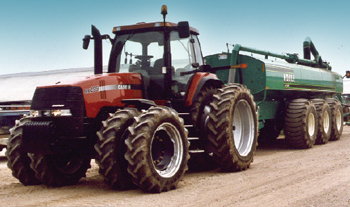 Manure management equipment on the 3,800-cow Green Meadow Farms includes a Houle tank (above), as well as Houle agitation equipment. Manure management equipment on the 3,800-cow Green Meadow Farms includes a Houle tank (above), as well as Houle agitation equipment. |
Green Meadow Farms, of Elsie, Michigan, installed a manure digester back in the 1980s. They operated it for seven years, and it involved one heck of a lot of work. “We were using sawdust for bedding at the time and there was no real way of cleaning it,” says Velmar, who manages Green Meadow Farms with his brother, Duane, and their families. “We ended up spending too much time with the digester and too much time with the generator, so we closed it down.”
But, as the saying goes, that was then, and this is now.
This fall, a new digester system will be starting up at the 3,800-cow Green Meadow Farms Dairy. And since the farm will have some partners in operating the digester system this time around, Velmar is looking forward to it.
“We’re working closely with Michigan State University on the digester part of it,” he explains. “And on the generator side, we have an agreement with a company, North American Natural Resources, which collects methane from landfills in the area. They’ll run the methane through their generator and sell it to the local utility, Consumer’s Power. All we have to do is provide them with the methane from our manure.”
The customers of Consumer’s Power have the opportunity to participate in a comprehensive renewable energy program called Green Generation. The program offers renewable energy from wind and landfill gas—and soon, methane gas from manure.
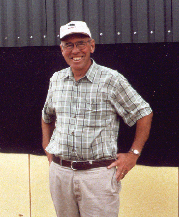 Michigan dairyman Velmar Green did not hesitate to give digesters another go. “We needed to try it again—I’m the one who pushed going ahead with this,” he says. Michigan dairyman Velmar Green did not hesitate to give digesters another go. “We needed to try it again—I’m the one who pushed going ahead with this,” he says. |
“We’re not getting the optimum advantage from selling the power directly to the utility,” says Velmar. “But then we don’t have the upfront costs of the generator—plus we don’t have the ongoing work and operational costs associated with the generator.”
Velmar says that even though their first digester set-up did not work out, he did not hesitate to give it another go. “We needed to try it again—I’m the one who pushed going ahead with this.”
Things were active at Green Meadow Farms this spring and summer—with all the digester and related construction going on. But it took a while to get this project going.
Michigan State University had been applying for grants for a full scale digester program for several years. In June 2005, the Michigan Public Service Commission (MPSC) awarded a $2 million grant to MSU’s Biosystems and Agricultural Engineering Department to build an anaerobic digester and related innovative manure treatment technologies at Green Meadow Farms. The grant came from a Low-Income and Energy Efficiency Fund established in 2004 to promote energy efficiency. The farm was selected for the project because of its long relationship with the university. MSU’s veterinary school has a teaching research center at Green Meadow.
Administering the project on behalf of the university are William Bickert, Dana Kirk and James Wallace. Kirk and Wallace are grad students under Bickert, who is professor and extension leader in the Biosystems and Agricultural Engineering Department.
The objective of the project is to demonstrate profitable energy production on a dairy farm, with the implications to environmental protection, carbon sequestration and sustainability of agriculture. Other sources of biomass including crop residues, crops produced specifically for biomass, food waste and forest products will be included. The goal is to be able to develop a manure management system—and related innovative enterprises on a dairy farm—along the lines of another profit center. In short, making money from manure.
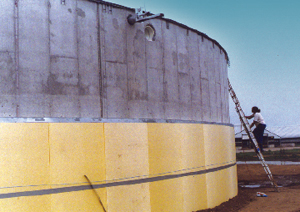 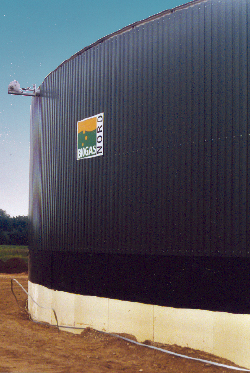 Michigan State University opted to go with a digester system from a German company, Biogas Nord. The Biogas Nord roof system—the roofs can be easily removed to gain access to the inside of the tanks for cleaning—appealed to the university, especially since Green Meadow Farms is a sand bedded dairy. Michigan State University opted to go with a digester system from a German company, Biogas Nord. The Biogas Nord roof system—the roofs can be easily removed to gain access to the inside of the tanks for cleaning—appealed to the university, especially since Green Meadow Farms is a sand bedded dairy. |
The anaerobic digester represents one of the first newly constructed digesters on a Michigan farm in more than 20 years and—an interesting sidenote—it will be operating on a dairy farm, Green Meadow Farms, that uses sand for freestall bedding. Essentially, msu and mpsc are looking for the facility to serve as a place to test and demonstrate the next generation of manure treatment technologies. Green Meadow Farms already has sand-manure separation systems, a phosphorous removal system and a composting operation that will become integral components of the manure management system.
According to MSU and MPSC, this facility will be the only one of its kind in North America, a place for farmers to study cutting-edge technology in a commercial setting and to obtain hands-on experience with actual systems. Personnel can be trained in the operation and maintenance of a digester and associated systems, and consulting engineers already schooled in the design, construction and operation of municipal and industrial wastewater treatment systems will be able to extend their knowledge base to agriculture.
It’s hoped that Michigan dairy farmers will be beneficiaries through decreased costs of manure management on their own farms and realization of profits from integrated systems due to increased efficiency in energy production and sale of value-added products.
An integrated system such as this also has the potential to stabilize manure, capture energy from the manure stream, effectively manage nutrients, capture greenhouse gases and reduce odors and pathogens. More effective and convenient use of manure nutrients can reduce use of fertilizers manufactured from fossil fuel energy.
Dana Kirk of MSU says the addition of the digesters will mean some changes for Green Meadow Farms. “From a nutrient management aspect, the digester will not have a significant impact, but it will have a significant impact on general farm management.”
The university opted to go with a digester system from a German company, Biogas Nord, for the project. “An important feature for us in the selection of Biogas Nord is that we were able to contract with one company to do all of the construction and the purchasing of all the major components,” says Kirk. Biogas Nord was essentially the general contractor on the project.
“But the roof system that Biogas has was also very appealing to us, especially on a sand bedded dairy, where we are going to have sand accumulating in the tanks.” The roofs on the Biogas tanks can be easily removed to gain access inside for cleaning, and can be just as easily put back on. “Even on a farm that does not use sand, there will still be grit accumulation at the bottom of the tanks, and they would have to be cleaned out,” adds Kirk.
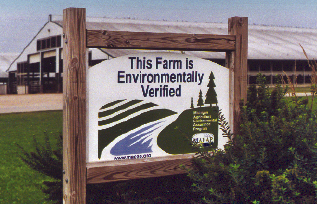 Green Meadow Farms is environmentally verified under the Michigan Agriculture Environmental Assurance Program (MAEAP). MAEAP is a voluntary, pro-active program that assists livestock operations with the management of nutrients—particularly nutrients in manure. Green Meadow Farms is environmentally verified under the Michigan Agriculture Environmental Assurance Program (MAEAP). MAEAP is a voluntary, pro-active program that assists livestock operations with the management of nutrients—particularly nutrients in manure. |
There were other attractive features to the system. “From a research standpoint, we wanted to have a redundant system, a system with multiple tanks that we could set up, side by side, with different operational management schemes.”
With the three Biogas Nord tanks (which have a total capacity of 900,000 gallons), they can have a system in a series—where manure is moving from one tank to the next—or parallel, where each of the three tanks is operating individually with a different system, with one-third of the farm’s manure directed to each tank.
“Or we could separate out one tank and run it on a longer retention time or shorter retention time while the other two tanks run together with the rest of the manure,” explains Kirk. “The flexibility of the system was very important.”
One likely project would see one of the tanks set up as a vertical plug flow digester for a smaller dairy, around 500 to 1,000 cows, while the other two tanks would run on an intermittent mix from Green Meadow Farms.
German-based Biogas Nord is an engineering firm that has specialized in the development, planning, construction and operation of biogas plants since the mid-1990s. The company has a strong focus on the construction of biogas plants for the treatment of manure and/or waste material. The company’s expertise is said to encompass all areas of biogas technology including concept development and planning, implementation planning, construction, implementation and operation. The company says its biogas plants are well regarded for their ease of maintenance, low repair requirements and cost-effectiveness.
Biogas Nord faced a bit different situation with the Green Meadow project, versus a conventional digester system. “They had to do some things differently and it was a little bit of a challenge and learning experience for both parties,” says Kirk. “Because we wanted to have the option to operate the tanks in series or parallel systems, it required some additional piping and plumbing. The biggest challenge was to plumb the system to allow the flexibility that we were looking for.”
Separately from the work Bio Nord is doing, the university is adding additional instrumentation that allows them to isolate each tank. They are also adding other equipment, such as a Walker Process heat exchanger, to increase heat efficiency. Vogelsang pumps and Flygt mixers are also being installed.
“We’re dealing with a diluted stream from the sand manure separators so the volume is double what it would normally be with a dairy this size. So instead of having 75,000 gallons, we have 150,000 gallons, with 75,000 gallons of that being dilution water.”
The research opportunity this large-scale digester project represents is very exciting, says Kirk. “That’s why the university wanted to be involved and was seeking a grant for this type of project. There seems to be a gap in the technology information for manure treatment systems on a commercial scale,” he adds.
“A lot of work is done in labs, on bench scale and pilot scale, but the technology often stops there because there is not a place to transfer it. We want to translate those lab experiences to the real world.” In effect, the digester will become a large commercial laboratory.
This digester laboratory will include a research center for MSU’s Biosystems and Agricultural Engineering Department, which is being built at the farm. Staff at the center will do work in treatment technologies to enhance nitrogen separation, phosphorus separation and pathogen inhibition.
“It’s a good fit because Green Meadow is already involved with the university’s vet school,” explains Kirk. “We can do a lot of work between our engineers and the vets to look at animal health. They have the capabilities to do microbial work, and there are some interesting studies that can come out of this. One of these would be an evaluation of manure solids bedding versus sand bedding. There’s a lot of interest in that today.”
That research would include comparing the two bedding approaches from the barns through to milk quality and yield, right through to manure management.
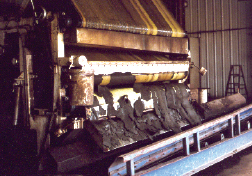 Manure is treated with ferric chloride and polymers and then run through a belt filter press. The end result is a phosphorus-dense solid cake that is composted and then marketed with a partner. Manure is treated with ferric chloride and polymers and then run through a belt filter press. The end result is a phosphorus-dense solid cake that is composted and then marketed with a partner. |
“The highest priority, though, is going to be nutrient management, and that means finding treatments and technologies to allow farms to better manage their nitrogen and phosphorus. We want to be able to prove out equipment that is cost effective for farmers.”
Once construction is complete, the university will have a good deal of input into the way in which the digesters will operate, but will essentially hand over day-to-day operation of the digester to Green Meadow Farms. The farm is responsible for operating the digester and optimizing its performance with the university.
The power generation/sales arrangement with North American Natural Resources seems to be a good fit, says Kirk. “Green Meadow can then focus on their core business of milking cows and managing manure, and North American Natural Resources is responsible for converting the gas into electricity and the interconnection. It’s a good collaborative relationship between the three different parties.” Powering the North American Biofuels system is a Caterpillar generator.
Taking on all this is not unusual for Green Meadow Farms. Kirk has known the Green family for a long time, and says they are well known for being trail blazers. “They have taken on things that have been outside of boundaries of the conventional and pushed their envelope,” says Kirk.
And he notes that not every dairy is willing to open its farm gates to vet students and—with the new digester—a group of ag engineers. But even the farm’s motto underscores their openness: “Where the latchstring is always out.”
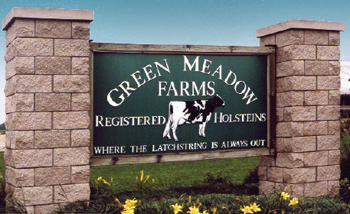 Green Meadow Farms, which is the largest Registered Holstein Herd in North America, has developed its own manure management system. Green Meadow Farms, which is the largest Registered Holstein Herd in North America, has developed its own manure management system.
|
And they’re used to having people from outside around the farm. Green Meadow Farms is the largest registered Holstein herd in North America and markets cows all over North America. And as well as their involvement with the university through the veterinary college and the digester project, the farm is also home to the MSU Training Center for Dairy Professionals. This is a training partnership between the farm, Land O’ Lakes Purina Mills LLC, Greenstone Farm Credit and the university.
The Green family takes quiet pride in being innovative. “We’ve tried to be pioneers,” explains Velmar. He adds that it’s probably not the most profitable way to do things, but it makes it more interesting and helps to keep them on top of technology.
Velmar notes that they were the first dairy farm to do sand separation, and they have the first models of McLanahan separators to prove it. “We worked with the university and McLanahan on that project,” notes Velmar. They now have six McLanahan separators.
They also developed their own system, in which manure is treated with ferric chloride and polymers, and then run through a belt filter press. The end result is a phosphorus-dense solid cake that is composted. The dairy is now marketing the compost with a partner. “We’re not big yet, but the company we are partnering with is seeing sales grow dramatically, and we were practically sold out for this year.”
For Velmar Green, getting involved with the digester project is just a continuation of the progressive approach Green Meadows likes to take to farm management—an approach that dates back to his father, Merle. “I guess we’re kind of continuing a family tradition.”